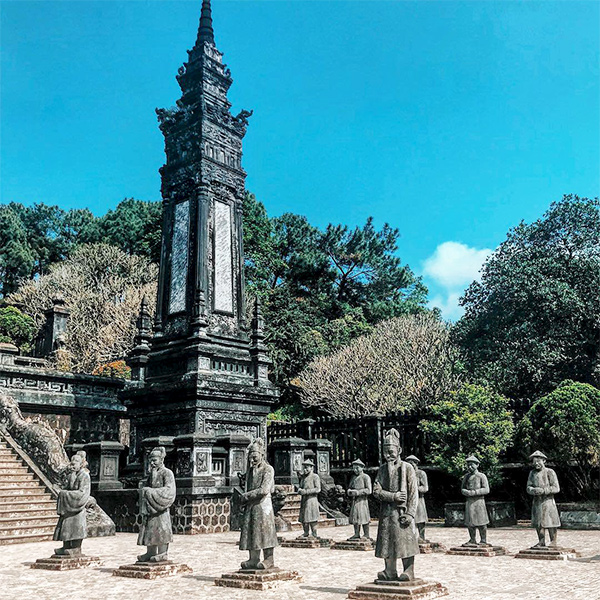

Hanoi Etoco - A travel company in Vietnam © Since 2001
Perfume River
Perfume River with the shimmer blue limpid color, is like a pearl in the sun. On both sides of the river, there are many interesting see sights such as: the forbidden citadel, town, gardens, pagodas, towers and temples...etc, and their reflections in the waters make the lovely river even more poetic and romantic. For a long time, the blue limpid Perfume River have become the symbol of Hue city
Thien Mu Pagoda
Thien Mu Pagoda: The pagoda is situated on Ha Khe Hill, on the left bank of Perfume River, 5 kilometers from Hue. Thien Mu, the name of the pagoda originated in a legend saying that an old woman appeared on the hill; she told the local people that a Lord would come and build a Buddhist pagoda for the country's prosperity. Lord Nguyen Hoang, on hearing that, commanded the construction of the pagoda on the hill and named it the "Heavenly Lady". The pagoda is built in an octagonal shape with seven tiers, enshrining the bronze cast statues and housing precious items. The surrounding area is adorned with flower gardens and beautiful plants. The trip to Thien Mu Pagoda is mostly done by a boat cruise on the Perfume River which offers the picturesque countryside along the river.
The Mieu
Situated southwest of the Citadel and facing south, The Mieu Temple is dedicated to ten Emperors of the Nguyen dynasty. Built by Emperor Minh Mang in 1821, it presents a 9-compartment main building and a 11-compartment front building, together connected in the "double" architecture with two bays on east and west sides. It is roofed with yellow enameled tiles and on the ridge rests a wine gourd decorated with Phap Lam enamel.
Many personal paraphernalia of great value which belonged to the Nguyen Emperors are kept in the temple. On each altar were once dozens of gold ingots. Fortunately enough, the temple has suffered the least damage through the numerous wars and today visitors can see it as it was originally built
Tu Duc's tomb
Tu Duc's tomb is one of the most beautiful works of royal architecture of the Nguyen Dynasty. The tomb lies in a boundless pine forest, 8 km from Hue, built from December 1864 to 1867.
On the left of the temple is the necropolis itself slopping upward with the Honor Courtyard, the Stele Pavilion, and the sepulcher. Right behind Bai Dinh, with two rows of magnificent military and civil mandarins, is Bi Dinh (Stele Pavilion) with the biggest stone stele in Vietnam. It is inscribed with Khiem Cung narrative, composed by the Emperor himself, writing about his life and imperial cause as well as his misadventures and diseases, etc. On the hill, opposite the semi-circular Tieu Khiem Tri lake, is the Buu Thanh brick wall, in the middle is a stone house, where the Emperor was buried.
Tu Duc's tomb is not only one of the most beautiful works of the Nguyen dynasty, but it is also a romantic scenery of mounts and lakes.
Khai Dinh Tomb
Emperor Khai Dinh came to the throne in 1916 and he chose the slope of Chau Chu mountain, 10 km from Hue, as the location to build his tomb. The construction of the tomb was started on Sept 4th 1920 and lasted for 11 years.
In comparison with those of the preceding emperors, Khai Dinh’s tomb is much smaller in surface but it is very elaborate. It is the result of the interminglement of many architectural trends: European and Asian, as well as ancient and modern.
The Khai Thanh Palace is the main room of the Thien Dinh palace. The walls are densely decorated and inlaid with elaborate glass and porcelain designs. The floor is covered with enameled flowers bricks and the ceiling is painted with nine dragons, appearing in fine fleeting clouds.
The tomb of Khai is one of the most surprising among the royal tombs of Hue
Minh Mang's Tomb
Built in Sep 1840 and fully completed in 1843, Minh Mang's tomb is a standard architectural complex consisting of 40 constructions (palaces, temples, pavilions...etc.) designed on an symmetric axis running from Dai Hong gate to the foot of La Thanh (Surrounding Wall) behind the Emperor's tomb.
The constructions are distributed into three main parallel axis of which Than Dao path is the centre.
Dai Hong Mon: It is the main gate to enter the tomb. The gate presents three paths with 24 heaving roofs covered with beautiful decorations. The gate was opened only once to bring the Emperor's coffin to the tomb, and had been tightly closed since then.
Visiting Minh Mang's tomb, one is impressed by the majesty and symmetry of the architectural constructions
Forbidden Citadel
The construction of the Citadel started in 1805 during the reign of Emperor Gia Long of the Nguyen Dynasty. The successive kings of the dynasty have ordered to build ramparts, palaces and other structure for royals. The exterior citadel has 24 bastions on the top of the wall for defensive purpose.
At the center of the Citadel, locates the Imperial City which was the seat of the highest offices of Vietnam's Feudalism. The Imperial City's compound is connected with the outer citadel by four entrance gates, among which the Noon Gate is only used for the king. The area of Imperial city is divided into sectors, packed with more than 100 beautiful buildings and structures.
The Forbidden Purple City is also located in the Imperial City. This area is uniquely reserved for Emperors and his royal family. More than 50 architectural buildings were built in different shapes and different purposes, including the Emperor's Private Palace, palace for conducting political affairs, Queen's residence, royal theatre, Emperor's library, kitchen, etc.
 Khai Dinh Tomb in Hue
Khai Dinh Tomb in Hue